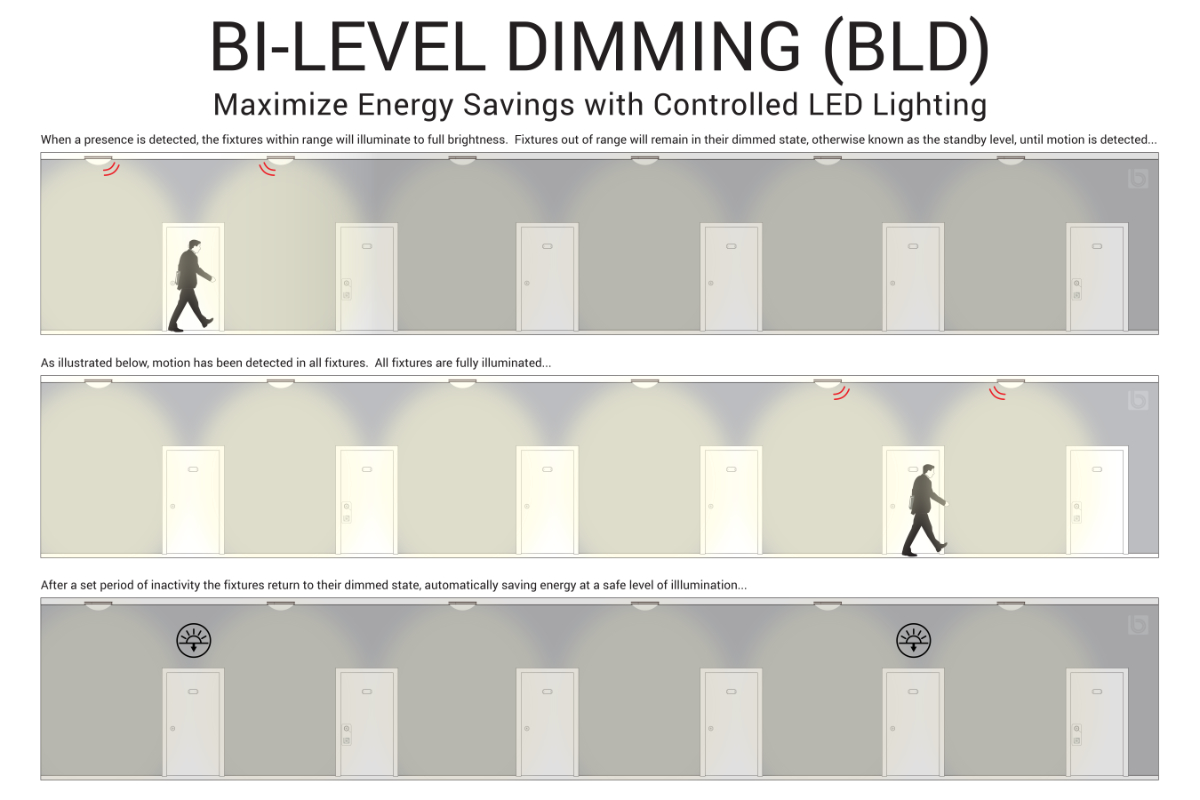No confusing software interface, no massive investment, no need to worry about your Wi-Fi or internet going down, no need to "update." Brownlee's Bi-Level Dimming control maximizes energy savings and is simpler than ever by combining an occupancy sensor, a timer, and customizable three-step dimming switches to easily configure your desired settings during installation.

How It Works
When the control senses movement, it raises the fixture’s light level to 100% output and remains at full brightness as long as it senses movement. After movement is no longer detected, its internal timer begins counting. If the set period of time expires, the fixture will dim down to your selected dimming level (50%, 30%, 20%, or 10% light output). Depending on your selected timer settings, the fixture can either remain at this dimmed level for a continuous amount of time or turn completely off after a set period of inactivity. Once the fixture senses movement again, it will return to full output, and the process begins again.
Read more: Can you provide a step-by-step guide for installing LED lights on a concrete pool deck?
Bringing Energy Savings to More Areas
While Bi-Level Dimming is commonly used in industrial fixtures for commercial stairwells and parking garages, Brownlee Lighting is pioneering the effort to bring this technology to the decorative market. The goal is to maximize energy savings in as many areas as possible. Don't forget to reach out to your local utility for rebate opportunities with this control.
Integrally Installed and Efficient
The Bi-Level Dimming control is seamlessly installed within the fixture by Brownlee, beneath the diffuser, ensuring it remains hidden from view. This ensures a clean and neat appearance for your décor.

Sync Up for Simultaneous Control
Fixtures with Bi-Level Dimming can be hard-wired together in sets for simultaneous control if desired. One fixture with Bi-Level Dimming can also be hard-wired with up to two other non-BLD fixtures, as long as the non-BLD fixtures contain 0-10V dimming drivers (DIM). It's important to note that the detection range of the BLD control is 19 feet, so careful planning is necessary. For example, if you have a corridor with 9 ceiling fixtures, you may be able to use three fixtures with Bi-Level Dimming and six with 0-10V DIM only. Each BLD unit will then need to be hard-wired (daisy chained) to their other two respective DIM units in the field, but the non-BLD fixtures must be within 19 feet of the BLD fixture to prevent causing a dead zone with no detection. While hard-wiring a corridor retrofit may not be practical, most customers simply order one BLD unit per fixture.
Read more: How Long Do LED Pool Lights Last?
Frequently Asked Questions
Q: Can Bi-Level Dimming be used in residential applications?
A: While Bi-Level Dimming is commonly used in commercial settings, it can be applied to residential applications as well. Check with your local utility or contact Brownlee Lighting for more information.
Q: Does Bi-Level Dimming require an internet connection or software updates?
A: No, Bi-Level Dimming does not require an internet connection or software updates. It is a standalone control system that is easy to install and use.
Q: Can I adjust the dimming level of Bi-Level Dimming?
A: Yes, Bi-Level Dimming allows for customizable three-step dimming switches. You can select your desired dimming levels during installation.
Q: Are there any rebates available for Bi-Level Dimming control?
A: It's always good to check with your local utility for rebate opportunities. They may offer incentives for implementing energy-saving controls like Bi-Level Dimming.
Q: How far can the Bi-Level Dimming control detect movement?
A: The Bi-Level Dimming control has a detection range of 19 feet. Keep this in mind when planning your installation to ensure proper coverage.
Q: Can the Bi-Level Dimming control be used with non-BLD fixtures?
A: Yes, one fixture with Bi-Level Dimming can be hard-wired with up to two other non-BLD fixtures, as long as the non-BLD fixtures contain 0-10V dimming drivers (DIM).
Read more: How Many Lights Should You Have in a Pool?
